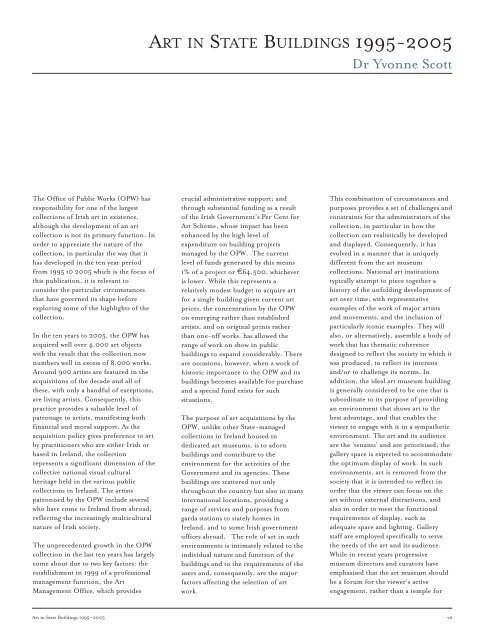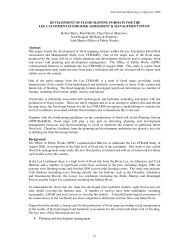Art in State Buildings 1995 to 2005 - The Office of Public Works
Art in State Buildings 1995 to 2005 - The Office of Public Works
Art in State Buildings 1995 to 2005 - The Office of Public Works
Create successful ePaper yourself
Turn your PDF publications into a flip-book with our unique Google optimized e-Paper software.
ART IN STATE BUILDINGS <strong>1995</strong>-<strong>2005</strong><br />
Dr Yvonne Scott<br />
<strong>The</strong> <strong>Office</strong> <strong>of</strong> <strong>Public</strong> <strong>Works</strong> (OPW) has<br />
responsibility for one <strong>of</strong> the largest<br />
collections <strong>of</strong> Irish art <strong>in</strong> existence,<br />
although the development <strong>of</strong> an art<br />
collection is not its primary function. In<br />
order <strong>to</strong> appreciate the nature <strong>of</strong> the<br />
collection, <strong>in</strong> particular the way that it<br />
has developed <strong>in</strong> the ten year period<br />
from <strong>1995</strong> t0 <strong>2005</strong> which is the focus <strong>of</strong><br />
this publication, it is relevant <strong>to</strong><br />
consider the particular circumstances<br />
that have governed its shape before<br />
explor<strong>in</strong>g some <strong>of</strong> the highlights <strong>of</strong> the<br />
collection.<br />
In the ten years <strong>to</strong> <strong>2005</strong>, the OPW has<br />
acquired well over 4,000 art objects<br />
with the result that the collection now<br />
numbers well <strong>in</strong> excess <strong>of</strong> 8,000 works.<br />
Around 900 artists are featured <strong>in</strong> the<br />
acquisitions <strong>of</strong> the decade and all <strong>of</strong><br />
these, with only a handful <strong>of</strong> exceptions,<br />
are liv<strong>in</strong>g artists. Consequently, this<br />
practice provides a valuable level <strong>of</strong><br />
patronage <strong>to</strong> artists, manifest<strong>in</strong>g both<br />
f<strong>in</strong>ancial and moral support. As the<br />
acquisition policy gives preference <strong>to</strong> art<br />
by practitioners who are either Irish or<br />
based <strong>in</strong> Ireland, the collection<br />
represents a significant dimension <strong>of</strong> the<br />
collective national visual cultural<br />
heritage held <strong>in</strong> the various public<br />
collections <strong>in</strong> Ireland. <strong>The</strong> artists<br />
patronised by the OPW <strong>in</strong>clude several<br />
who have come <strong>to</strong> Ireland from abroad,<br />
reflect<strong>in</strong>g the <strong>in</strong>creas<strong>in</strong>gly multicultural<br />
nature <strong>of</strong> Irish society.<br />
<strong>The</strong> unprecedented growth <strong>in</strong> the OPW<br />
collection <strong>in</strong> the last ten years has largely<br />
come about due <strong>to</strong> two key fac<strong>to</strong>rs: the<br />
establishment <strong>in</strong> 1999 <strong>of</strong> a pr<strong>of</strong>essional<br />
management function, the <strong>Art</strong><br />
Management <strong>Office</strong>, which provides<br />
crucial adm<strong>in</strong>istrative support; and<br />
through substantial fund<strong>in</strong>g as a result<br />
<strong>of</strong> the Irish Government’s Per Cent for<br />
<strong>Art</strong> Scheme, whose impact has been<br />
enhanced by the high level <strong>of</strong><br />
expenditure on build<strong>in</strong>g projects<br />
managed by the OPW. <strong>The</strong> current<br />
level <strong>of</strong> funds generated by this means<br />
1% <strong>of</strong> a project or E64,500, whichever<br />
is lower. While this represents a<br />
relatively modest budget <strong>to</strong> acquire art<br />
for a s<strong>in</strong>gle build<strong>in</strong>g given current art<br />
prices, the concentration by the OPW<br />
on emerg<strong>in</strong>g rather than established<br />
artists, and on orig<strong>in</strong>al pr<strong>in</strong>ts rather<br />
than one-<strong>of</strong>f works, has allowed the<br />
range <strong>of</strong> work on show <strong>in</strong> public<br />
build<strong>in</strong>gs <strong>to</strong> expand considerably. <strong>The</strong>re<br />
are occasions, however, when a work <strong>of</strong><br />
his<strong>to</strong>ric importance <strong>to</strong> the OPW and its<br />
build<strong>in</strong>gs becomes available for purchase<br />
and a special fund exists for such<br />
situations.<br />
<strong>The</strong> purpose <strong>of</strong> art acquisitions by the<br />
OPW, unlike other <strong>State</strong>-managed<br />
collections <strong>in</strong> Ireland housed <strong>in</strong><br />
dedicated art museums, is <strong>to</strong> adorn<br />
build<strong>in</strong>gs and contribute <strong>to</strong> the<br />
environment for the activities <strong>of</strong> the<br />
Government and its agencies. <strong>The</strong>se<br />
build<strong>in</strong>gs are scattered not only<br />
throughout the country but also <strong>in</strong> many<br />
<strong>in</strong>ternational locations, provid<strong>in</strong>g a<br />
range <strong>of</strong> services and purposes from<br />
garda stations <strong>to</strong> stately homes <strong>in</strong><br />
Ireland, and <strong>to</strong> some Irish government<br />
<strong>of</strong>fices abroad. <strong>The</strong> role <strong>of</strong> art <strong>in</strong> such<br />
environments is <strong>in</strong>timately related <strong>to</strong> the<br />
<strong>in</strong>dividual nature and function <strong>of</strong> the<br />
build<strong>in</strong>gs and <strong>to</strong> the requirements <strong>of</strong> the<br />
users and, consequently, are the major<br />
fac<strong>to</strong>rs affect<strong>in</strong>g the selection <strong>of</strong> art<br />
work.<br />
This comb<strong>in</strong>ation <strong>of</strong> circumstances and<br />
purposes provides a set <strong>of</strong> challenges and<br />
constra<strong>in</strong>ts for the adm<strong>in</strong>istra<strong>to</strong>rs <strong>of</strong> the<br />
collection, <strong>in</strong> particular <strong>in</strong> how the<br />
collection can realistically be developed<br />
and displayed. Consequently, it has<br />
evolved <strong>in</strong> a manner that is uniquely<br />
different from the art museum<br />
collections. National art <strong>in</strong>stitutions<br />
typically attempt <strong>to</strong> piece <strong>to</strong>gether a<br />
his<strong>to</strong>ry <strong>of</strong> the unfold<strong>in</strong>g development <strong>of</strong><br />
art over time, with representative<br />
examples <strong>of</strong> the work <strong>of</strong> major artists<br />
and movements, and the <strong>in</strong>clusion <strong>of</strong><br />
particularly iconic examples. <strong>The</strong>y will<br />
also, or alternatively, assemble a body <strong>of</strong><br />
work that has thematic coherence<br />
designed <strong>to</strong> reflect the society <strong>in</strong> which it<br />
was produced, <strong>to</strong> reflect its <strong>in</strong>terests<br />
and/or <strong>to</strong> challenge its norms. In<br />
addition, the ideal art museum build<strong>in</strong>g<br />
is generally considered <strong>to</strong> be one that is<br />
subord<strong>in</strong>ate <strong>to</strong> its purpose <strong>of</strong> provid<strong>in</strong>g<br />
an environment that shows art <strong>to</strong> the<br />
best advantage, and that enables the<br />
viewer <strong>to</strong> engage with it <strong>in</strong> a sympathetic<br />
environment. <strong>The</strong> art and its audience<br />
are the ‘tenants’ and are prioritised; the<br />
gallery space is expected <strong>to</strong> accommodate<br />
the optimum display <strong>of</strong> work. In such<br />
environments, art is removed from the<br />
society that it is <strong>in</strong>tended <strong>to</strong> reflect <strong>in</strong><br />
order that the viewer can focus on the<br />
art without external distractions, and<br />
also <strong>in</strong> order <strong>to</strong> meet the functional<br />
requirements <strong>of</strong> display, such as<br />
adequate space and light<strong>in</strong>g. Gallery<br />
staff are employed specifically <strong>to</strong> serve<br />
the needs <strong>of</strong> the art and its audience.<br />
While <strong>in</strong> recent years progressive<br />
museum direc<strong>to</strong>rs and cura<strong>to</strong>rs have<br />
emphasised that the art museum should<br />
be a forum for the viewer’s active<br />
engagement, rather than a temple for<br />
<strong>Art</strong> <strong>in</strong> <strong>State</strong> Build<strong>in</strong>gs <strong>1995</strong>–<strong>2005</strong><br />
vii

















